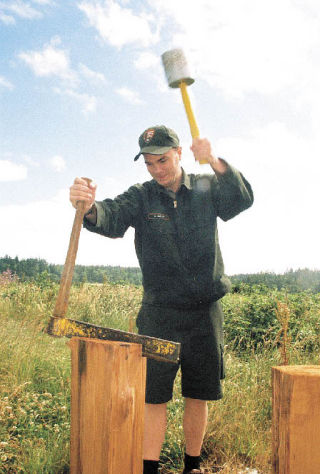Restoration project helps mark Reserve’s 30th Anniversary
The roof of a historic Coupeville building will be replaced the old fashioned way.
Groups of volunteers will descend upon the Alexander Blockhouse later this month to begin a month-long project replacing the roof of the historic, 153-year-old structure.
They will do more than replacing the roof, they also will be splitting the cedar shakes that will comprise the new top.
The Alexander Blockhouse, located between the canoe shed and the Island County Historical Museum in Coupeville, is the first community restoration project undertaken by Ebey’s Landing National Historical Reserve.
Volunteers will work in two shifts, four days a week to produce and install the new roof and complete other repairs that may come up.
“The community here has a tradition of service and that is what makes this project possible,” said Mark Preiss, manager of Ebey’s Landing National Historical Reserve.
The Coupeville Lions Club, of which Preiss is a member, is stepping up to the plate. Club members are providing the bulk of the labor for the project, but more volunteers are needed.
Coupeville Lions Club member Ron Boyer said there is a good cooperative relationship between the Lions and the Reserve.
“It’s a lot of fun. We like to do this stuff,” Boyer said. The Lions Club participated in a similar project last year when they helped restore the Davis Blockhouse, located near Sunnyside Cemetery.
The four-week volunteer effort is part of the Reserve’s Community Restoration Project, which was created to help involve more residents in preservation efforts.
Preiss said the Central Whidbey community has a good service ethic, and that’s a necessary attribute to have in the Reserve where approximately 80 percent of the land and most of the 300-plus historic structures, are privately owned.
The Alexander Blockhouse restoration is a good first project for the new program. Preiss said volunteers have a good idea of the structure’s condition, making the project more manageable.
Although the bulk of the restoration consists of replacing the roof, there could be additional work needed when the project begins.
“When you get into it, you never know what you’re going to find,” Preiss said.
Work has already started on the restoration. Workers this week moved the canoe shed, which was built in the 1920s, located next to the blockhouse. Rick Castellano, director of the museum, said the canoe shed had caused some dry rot where it was touching the blockhouse.
Volunteers also poured new concrete fittings for the canoe shed.
National Park Service staff also got a head start on making cedar shakes. Workers swung a mallet onto a froe, which is a blade, to split the shakes from blockS of cedar.
Castellano didn’t know the Alexander Blockhouse’s exact original location. The Alexander Farm was 320 acres in size and went from Coupeville out onto the prairie. Castellano said the blockhouse was probably located toward the prairie. It was originally built as a fortress to defend against Indians. He said the blockhouses on Whidbey Island were never used to defend against attacks. Instead, they became storage space.
Work installing the new roof is scheduled to begin July 21. Work times go Monday through Thursday from 8 a.m. to noon and from 1 to 5 p.m.
Prior to the start of the project, a workshop is scheduled for Thursday, July 17, 6 p.m. at the Reuble Barn located at the intersection of Fort Casey and Patmore roads. The restoration project is expected to take four weeks to complete. The workshop will provide information about the blockhouse but Preiss said attendance isn’t a requirement for participating in the restoration.
Preiss said the blockhouse restoration is a hands-on way for residents to learn about historic preservation. Those skills will be useful in future projects.
Craig Holmquist, acting operations manager for the Reserve, said he expects one community restoration project to take place each year marking the anniversary of the Reserve.
The community restoration project is one of a series of events commemorating the 30th anniversary of Ebey’s Landing National Historical Reserve. The anniversary culminates in early November with the first-ever, Ebey’s Forever Conference, which provides a chance to remember the history and look to the future of Ebey’s Reserve.
For more information about the Alexander Blockhouse restoration, call 678-6084. For information about the anniversary celebration, go to www.ebeysforever.com.



